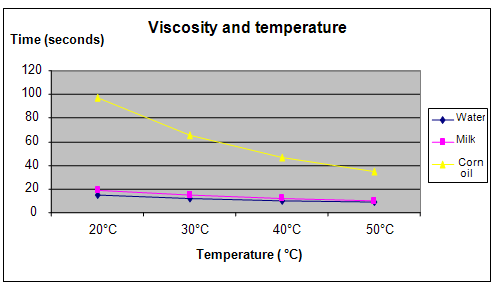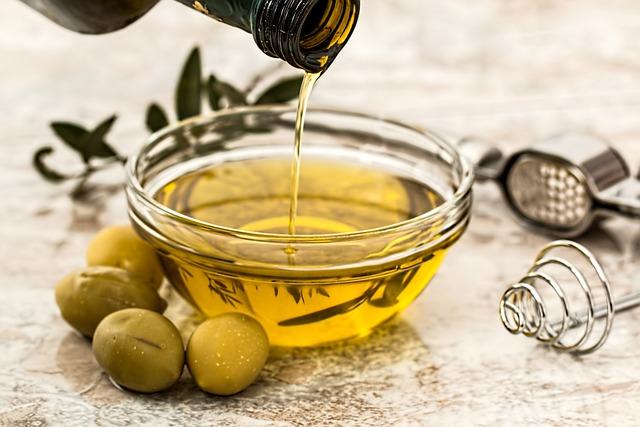| Complexity level: | 7 |
| Project cost ($): | 30 |
| Time required: | 1 hour to prepare, 2 hours for the science project experiment |
| Material availability: | Easily found |
| Safety concerns: | Basic safety requirements |
Hypothesis
Water has the lowest viscosity and the fastest rate of flow followed by milk, while corn oil has the highest viscosity.
Overview
Viscosity
Viscosity is the measurement of resistance by a fluid to deformations caused by tensile stress and shear stress. It is commonly referred to as the thickness of a fluid. A thick fluid will have higher viscosity and a thin fluid will have lower viscosity. Viscosity also refers to internal resistance experienced by the fluid before it can flow.
The presence of viscosity in a fluid is caused by internal friction in a substance. Both fluids and gasses are made up of adjacent layers. When external pressure is applied to a fluid, the friction that occurs between layers will determine the type of response and flow that will happen. The measurement of fluidity is the opposite of viscosity where the lack of fluid resistance is measured.
The viscosity of a fluid will be affected by its temperature. By increasing the temperature of a fluid, the viscosity is reduced. An example is butter, which is solid at room temperature. When heated, it will melt and the viscosity is lowered. Similarly, cooking oil will become thicker with a higher viscosity when kept in a refrigerator.
Scientific Terms
Materials
The materials required for this science fair project:
- 2 metal cups
- 1 electric drill with small sized drill bits
- 1 bottle of tap water
- 1 bottle of milk
- 1 bottle of corn oil
- 1 hot plate
- 1 thermometer
- 1 stopwatch
- An assistant
Procedure
1. For this experiment, the independent variable is the type of fluid used (water, milk and corn oil) and temperature. The dependent variable is the viscosity of the fluid. This is determined by using a measuring cup and a stopwatch to measure the flow rate. The constants (control variables) are the size of the hole in the cup and the volume of the cup.
2. An electric drill is used to make a small hole at the bottom of one of the two metal cups.
3. The water is kept at 20°C. The assistant will hold the cup with the hole over the 2nd cup with one finger covering the small hole at the bottom of the cup. The finger should be placed over the hole on the exterior of the cup. The cup is then filled with water . After the cup is filled, have a stopwatch ready. Simultaneously, the assistant removes the finger from the hole and the stopwatch is started. Water from the upper cup will fall into the lower cup through the hole. The time taken for the cup to empty, is recorded.
4. Procedure 3 is repeated 5 times and the average time is calculated by totaling the 5 measurements and dividing by 5. The results are recorded in the table given below.
5. Procedures 3 and 4 are repeated by bringing the temperature of the water to 30°C, 40°C and 50°C using the hot plate.
6. Procedures 3, 4 and 5 are repeated using milk and corn oil.

Results
It was observed that water had the fastest rate of flow and the corn oil had the slowest. The flow rate of water, milk and corn oil increased as the temperature increased.
|
Adhesive material |
Viscosity and flow rate of water, milk and corn oil at different temperatures (seconds) |
|||
|
20°C |
30°C |
40°C |
50°C |
|
|
Water |
15 |
12 |
10 |
9 |
|
Milk |
19 |
15 |
12 |
10 |
|
Corn oil |
97 |
65 |
47 |
35 |
The graph below represents the results of our science fair project:

Conclusion
The hypothesis that water has the lowest viscosity and the fastest rate of flow, followed by milk while corn oil has the highest viscosity, is proven to be true.
The understanding of viscosity and fluid dynamics is very important when transporting fluids like water, crude oil or natural gas through pipes over long distances. Changing climates and different temperatures will affect the viscosity and rate of flow of the fluid. Additional sensors and pumps are normally placed along the pipes to keep the rate of water flow constant.
Also consider
Try to repeat the science fair project using different fluids like honey, ethanol and engine oil.
The science project experiment can also be repeated using a larger hole in the cup, and observing if that makes any difference.
References
Viscosity - http://en.wikipedia.org/wiki/Viscosity
Specific gravity and viscosity of liquids - http://www.csgnetwork.com/sgvisc.html
What is viscosity? - http://www.wisegeek.com/what-is-viscosity.htm

